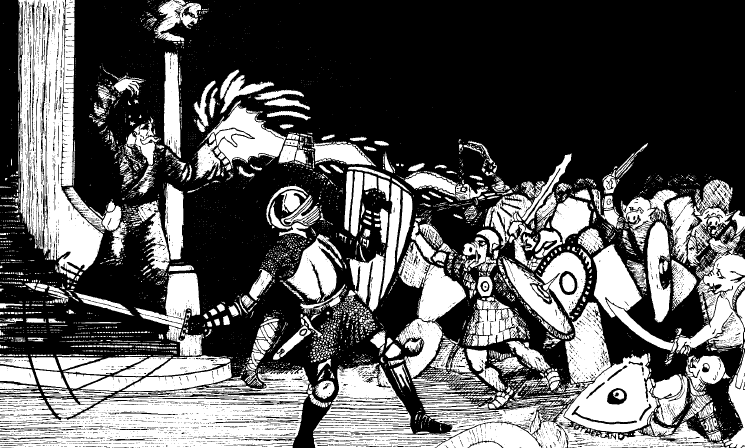 |
AD&D Armor by David C. Sutherland III |
The picture above should have been included in the 1E AD&D PHB or DMG. It illustrates the nine standard types of AD&D armor as described in those books, but appeared only in the relatively obscure AD&D Dungeon Masters Adventure Log, published in 1980.
Below are the corresponding descriptions from 1E AD&D Dungeon Masters Guide, page 27, plus a few notes from the shorter descriptions given on page 165. I've reordered them & included the encumbrance and move ratings from the table on page 27, and the armor classes and cost from the PHB. These use the unarmored AC 10 system that debuted in AD&D PHB, replacing the unarmored AC 9 system of OD&D.
Padded Armor (AC 8, MV 9", 10 lbs, 4 GP) is "heavily padded, quilted coat and an additional soft leather jerkin and leggings".
Leather Armor (AC 8, MV 12", 15 lbs, 5 GP) is "shaped cuir bouli (leather hardened by immersion in boiling oil) cuirass and shoulder pieces and softer shirt and leggings" (pg 27) and "includes boots and gauntlets" (pg 165).
Studded Leather (AC 7, MV 9", 20 lbs, 15 GP) is "leather armor to which have been fastened metal studding as additional protection, usually including an outer coat of fairly close-set studs (small plates)" (pg 27), and with "an extra layer of protection at shoulder area" (pg 165).
Ring Mail (AC 7, MV 9", 25 lbs, 30 GP) is "relatively soft leather armor over padding. To the long coat of leather are sewn metal rings. This makes the coat rather heavy and bulky".
Scale Mail (AC 6, MV 6", 40 lbs, 45 GP) is "armor similar to ring mail, but overlapping scales of metal are sewn to both coat and leggings—or a skirted coat is worn. As with chain, weight falls mainly on the wearer’s shoulders and waist".
Chain Mail (AC 5, MV 9", 30 lbs, 75 GP) is "padding plus interlocking mesh armor covering the upper and lower body. Vulnerable areas have multiple thicknesses. Weight falls upon the shoulders and waist of the wearer".
Splint Mail (AC 4, MV 6", 40 lbs, 80 GP) is "light chain, greaves, and a leather coat into which are laminated vertical pieces of plate with shoulder guards".
Banded Mail (AC 4, MV 9", 35 lbs, 90 GP) is "a layered armor with padding, light chain, and series of overlapping bands of armor in vulnerable areas. Weight is somewhat distributed".
Plate Mail (AC 3, MV 6", 40 lbs, 400 GP) is "light chain with pieces of plate — cuirass, shoulder pieces, elbow and knee guards, and greaves. Weight is well distributed".
Plate armor (AC 2, MV 9", 40 lbs, 2000 GP) is "a full suit of plate which is no more weighty and a bit less bulky, considering what is known as “field plate”" [This is an optional addition that Gygax mentions; it is not illustrated above. Rules for this were later expanded in Unearthed Arcana in 1985]
On page 165, Gygax refers the reader to Charles Ffoulkes' Armour and Weapons (1909), which thanks to the internet can be viewed here.
Original D&D and the Classic D&D successors only included Leather, Chain and Plate, so the additional armor types are typically associated with AD&D. However, many of them actually appeared all the way back in Chainmail Man-to-Man Melee Table:
Halflings: "The usual protection ... consists of padded or leather armor", with an AC of 7.
Wood Elf: "They usually wear studded leather or ring mail (AC 6)".
Gnomes: "...armored with leather armor which is ringed or well studded with metal and shield (armor class 5)".
Thus, if adapting these additional types to Holmes Basic or OD&D, we might use:
Padded Armor: AC 7, MV 9", 10 GP
Leather Armor: AC 7, MV 12", 15 GP
Studded Leather: AC 6, MV 9", 20 GP
Ring Mail: AC 6, MV 9", 20 GP
Scale Mail: AC 5, MV 6", 25 GP
Chain Mail: AC 5, MV 9", 30 GP
Splint Mail: AC 4, MV 6", 40 GP
Banded Mail: AC 4, MV 9", 45 GP
Plate Mail: AC 3, MV 6", 50 GP
Plate Armor: AC 2, MV 9", 200 GP
The AC & prices for Leather/Chain/Plate come from the original list in OD&D and Holmes Basic. In AD&D, there's little functional difference between Studded Leather and Ring, other than Ring being slightly heavier and costing twice as much, so I just left them as identical on this chart.
One practical use for this table in OD&D might be for adapting AD&D modules with these armor types.
See also: The Monster Manual is a Holmes Supplement
(DMs Guild links include affilitate #)

















